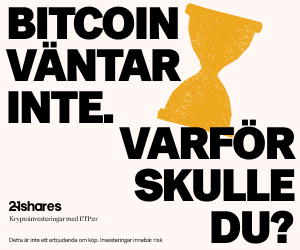Nyheter
Bitcoin’s Volatility and Stablecoin’s Market Viability: What Happened in Crypto This Week?
Publicerad
1 år sedanden

• Bullish, Bearish, or Both? Macro Mayhem Leads to Bitcoin Volatility
• Bitcoin’s Institutional Embrace is Accelerating
• Beyond Borders and Banks: Stablecoins Proving their Market Viability
Macro Mayhem Leads to Bitcoin Volatility
Last week, Bitcoin navigated a wave of conflicting U.S. macroeconomic events. The FOMC press conference last Wednesday confirmed the Fed will sustain high interest rates at 5.25-5.5% as the challenge of achieving the inflation target persists. As shown in Figure 1, this initially triggered Bitcoin’s price to drop by 5.9% as investors sought the safety of fixed-income assets. Friday’s U.S. Jobs report reversed the negative sentiment from the FOMC meeting. The report revealed a disappointing labor market, with only 175,000 non-farm jobs added, as unemployment rose to 3.9%. This data fueled hopes for rate cuts, which bodes well for risk-on assets, which led to Bitcoin rebounding by 6.7% to ~$63,000 by week’s end.
Figure 1: Bitcoin 1 Week Price Performance (April 29, 2024 – May 6, 2024)
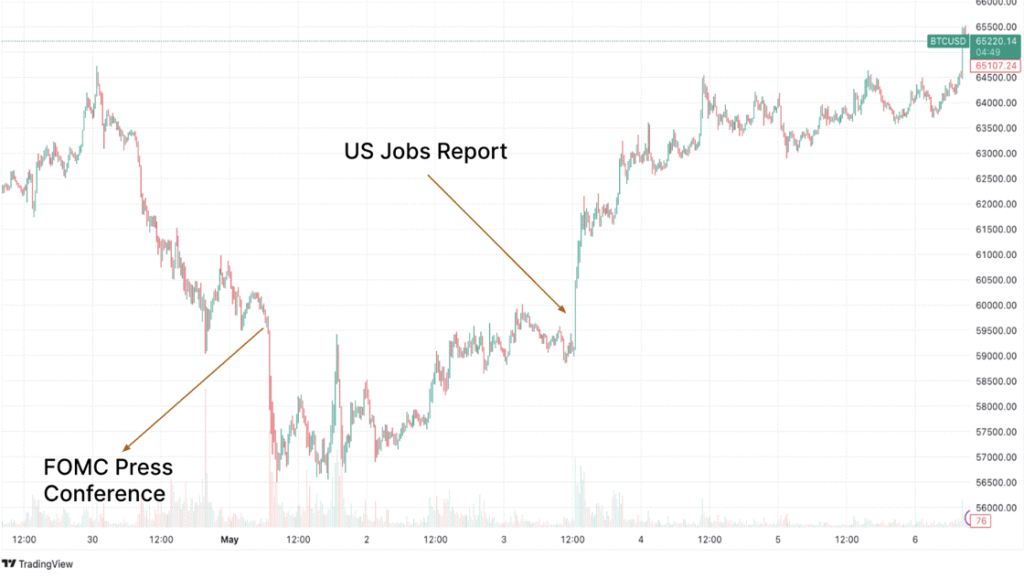
Source: TradingView
Looking ahead, several developments could provide tailwinds for Bitcoin. The upcoming Treasury buyback program, the first since 2002, is launching on May 29 and has several implications for the broader financial landscape. By conducting weekly bond buybacks of up to $2 billion, outstanding debt is reduced while liquidity is increased, which could allow capital to flow into riskier assets. The reduced bond supply also puts downward pressure on yields, potentially making Bitcoin more attractive.
The recent Treasury refinancing announcement also looks promising for Bitcoin. A lower target balance for the Treasury General Account (TGA) suggests the government needs to borrow less, which frees up capital. The impact could be compared to quantitative easing, instead of withdrawing liquidity from the market by selling new bonds, the Treasury effectively injects liquidity by not needing to borrow as much. This additional liquidity eventually reaches the banking system, potentially leading to easier access to credit and lower interest rates. As we have voiced throughout, this environment would benefit riskier assets like Bitcoin.
Despite the initial price drop triggered by the Fed’s hawkish stance on interest rates, Bitcoin’s resilience was evident in its subsequent rebound driven by a weakening labor market and the potential prospect of a dovish shift. As illustrated below, Bitcoin’s funding rate is now similar to when it was trading at around $29,000, which signals a healthy market adjustment, shedding excess leverage. Looking ahead, the upcoming Treasury actions will undoubtedly affect U.S. liquidity and interest rate levels, which are key to Bitcoin’s performance and will be closely monitored in the coming weeks.
Figure 2: Bitcoin’s Funding Rate

Source: Glassnode
Bitcoin’s Institutional Embrace is Accelerating
Fueled by the U.S. Bitcoin ETF launch, the institutional adoption of Bitcoin is accelerating. A staggering $175 billion is estimated to be held by ETFs, countries, and public and private companies, representing roughly 15% of the total Bitcoin supply. While miniscule compared to the U.S. launch, Hong Kong’s Bitcoin ETFs further exemplify this trend, accumulating 4.2K BTC, or nearly $270 million, within their first week of trading. This showcases the growing appetite for the asset, however the hunger for Bitcoin is not limited to Hong Kong. Ovata Capital Management’s $60 million allocation into the U.S. spot ETFs underscores this trend, which is set to continue as the May 15 deadline for 13F filings approaches, which may reveal previously undisclosed positions held by institutions.
Recent disclosures by BNY Mellon and BNP Paribas, along with Swiss funds Bellecapital International and Lugano Financial Advisors, provide further evidence of Bitcoin’s institutionalization. Moreover, according to BlackRock, the world’s largest sovereign wealth funds (SWFs), including Norway’s $1.6 trillion fund, Saudi Arabia’s Public Investment Fund, and Kuwait’s Investment Authority, are re-initiating discussions around Bitcoin. The SWF industry is valued at $11.6 trillion, therefore even a moderate allocation into the asset could see demand catapult to new levels, and provide a tipping point for broader adoption. Importantly, it is becoming more difficult to discount the asset – Bitcoin’s unique profile as both a risk-on and risk-off asset is becoming increasingly relevant given the complex macroeconomic landscape.
Further, Bitcoin’s adoption is transcending passive investment strategies. For instance, fintech giant Nubank, housing 80 million users, now offers crypto deposits and withdrawals, aiming to bridge the gap between traditional finance and crypto in Latin America. Lastly, Microstrategy, synonymous with their commitment to Bitcoin, are pushing the boundaries further by building an identity solution on the Ordinals network. This exemplifies the use of Bitcoin beyond a decentralized payment system, a notion we have echoed in the past weeks as Bitcoin continues to evolve beyond its original purpose.
Finally, the coming weeks promise further clues on the US economic trajectory and Bitcoin institutional adoption. There are eight Fed speaker events this week, and while they don’t directly address crypto, they often offer valuable insights into the current economic conditions. This, coupled with the turbulence expected during Q1 earnings season, could create volatility in equity markets, which may spill over to crypto as investors react accordingly.
Beyond Borders and Banks: Stablecoins Proving their Market Viability
After a six-year hiatus, Stripe is re-entering the crypto industry by enabling customers to accept stablecoins for online payments. Stripe was among the pioneers in integrating Bitcoin back in 2014. However, they ceased support in 2018 due to Bitcoin’s prolonged processing times and high transaction costs, which didn’t present a significant improvement over its traditional counterpart. Since then, the industry has undergone a major transformation, with the emergence of numerous smart-contract platforms and scaling efforts, enhancing the potential of crypto’s infrastructure to offer a superior user experience.
For instance, Stripe’s co-founder showcased a $100 USDC payment using Solana at the company’s annual conference. The demo corroborated how the payment was processed in less than a second instead of days while incurring $0.0037 in network fees, a cost reduction of almost 800-fold compared to a credit card. This is a testament to the advancements achieved by the latest generation of platforms, such as Solana, which addressed some of the drawbacks, like high transaction costs and lengthy processing times, while demonstrating their efficacy for use cases requiring a high volume of interactions, such as payments.
To that end, Stripe will begin supporting USDC payments through Ethereum, Solana, and Polygon. This integration marks a significant milestone, given Stripe’s substantial 35% market share in the payments industry. However, it’s even more crucial as users can seamlessly leverage the efficiencies of crypto’s infrastructure, ensuring reduced transaction costs and notably swifter processing times while remaining unaware of the use of blockchain technology in the backend. This mirrors how users are often unaware of the payment infrastructure their preferred fintech apps utilize. At 21Shares, we firmly believe that this kind of seamless integration is imperative for the widespread adoption of crypto.
That said, while Tether leads by market capitalization with $110 billion compared to USDC’s $33 billion, USDC actually dominates in terms of usage when looking at transaction volume. According to Visa’s latest on-chain analytical dashboard aiming to dissect the growth of the stablecoin sector, USDC is now responsible for more than 70% of all stablecoin payments, as illustrated below. As we’ve emphasized for years, exemplified by our own work on Dune, on-chain analytics represents the future of capital markets. It offers unparalleled transparency and real-time data access, unlike traditional industries reliant on periodic disclosures of quarterly financials. Therefore, Visa’s active engagement in on-chain analytics marks a watershed moment, reaffirming our long-held belief that this is the path forward.
Figure 3: Stablecoins Monthly Transaction Volume
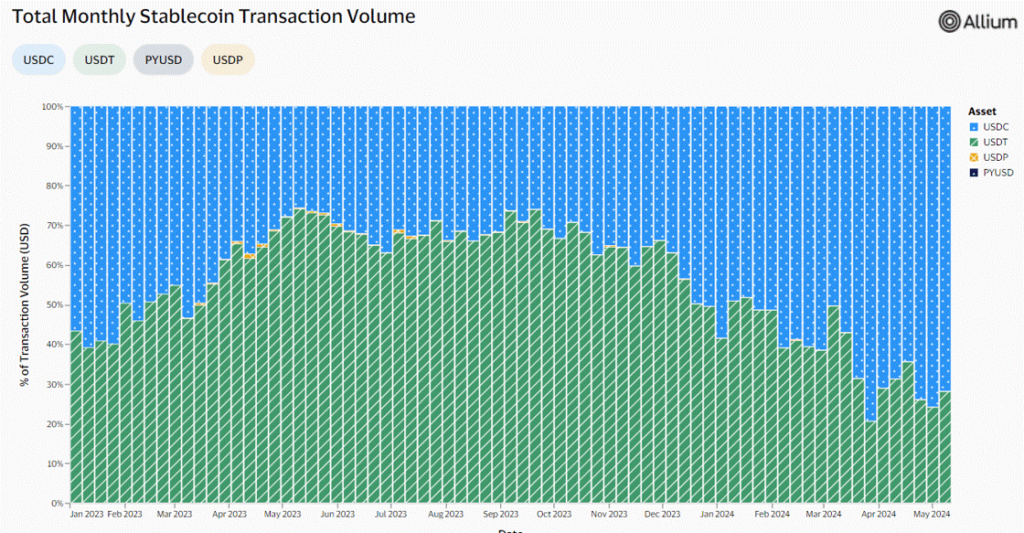
Source: Alluvium X Visa
Despite USDC’s widespread adoption, Tether has achieved remarkable financial success in Q1. The company raked in a staggering $4.52B in profits by strategically deploying user deposits into U.S. treasury and repurchase agreements. The exposure to debt, coupled with rising Bitcoin and Gold prices, has proven to be a lucrative formula. As a result, Tether’s net profit now eclipses that of financial giants like Citibank, Goldman Sachs, and Morgan Stanley, highlighting the burgeoning business potential of the fiat-backed stablecoin model.
Further, characterized by its disintermediated structure and emphasis on user experience, stablecoins have proven themselves as a viable alternative within the financial landscape. They are arguably one of crypto’s most compelling use cases right now. Its significance becomes even more apparent in regions facing economic instability, where users turn to stablecoins as a swift means to access the U.S. dollar, safeguarding themselves against currency devaluation. Turkey serves as a notable case study, stablecoin transactions account for a remarkable 4% of the nation’s GDP, the highest proportion globally, at a time when the Turkish Lira lost more than 75% of its value against the U.S. dollar over the last 5 years.
Finally, Tether is intensifying its efforts by launching USDT on the TON blockchain, which is closely linked to Telegram. Despite TON’s recent rise in popularity with approximately 1.74M users, it aims to tap into Telegram’s vast 900M user base through its deep integration. This move could significantly expand the market for stablecoins, currently serving around 25M users. Moreover, this integration is a pivotal step in simplifying crypto usage, concealing its complexities, and paving the way for mass adoption.
This Week’s Calendar

Source: Forex Factory, 21Shares
Research Newsletter
Each week the 21Shares Research team will publish our data-driven insights into the crypto asset world through this newsletter. Please direct any comments, questions, and words of feedback to research@21shares.com
Disclaimer
The information provided does not constitute a prospectus or other offering material and does not contain or constitute an offer to sell or a solicitation of any offer to buy securities in any jurisdiction. Some of the information published herein may contain forward-looking statements. Readers are cautioned that any such forward-looking statements are not guarantees of future performance and involve risks and uncertainties and that actual results may differ materially from those in the forward-looking statements as a result of various factors. The information contained herein may not be considered as economic, legal, tax or other advice and users are cautioned to base investment decisions or other decisions solely on the content hereof.
Du kanske gillar
-


FalconX förvärvar den ledande ETP-leverantören 21shares, vilket accelererar konvergensen av digitala tillgångar och traditionell finans
-


Bitcoin within 15% of its all-time high: Should you still allocate?
-


Globala krypto-ETPer förvaltade tillgångar når 250 miljarder dollar
-


Record crypto liquidations amid tariff shock
-
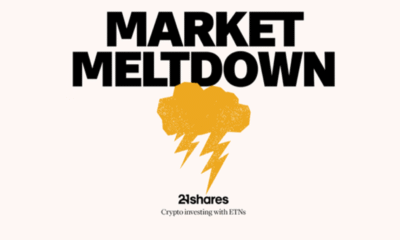

Crypto market update: record liquidations amid tariff shock
-


Bitwises Bradley Duke om Bitcoin och guld på nya rekordnivåer
Nyheter
FalconX förvärvar den ledande ETP-leverantören 21shares, vilket accelererar konvergensen av digitala tillgångar och traditionell finans
Publicerad
13 timmar sedanden
22 oktober, 2025
Förvärvet förenar FalconX marknadsledande Prime Brokerage-plattform med 21shares ETP-infrastruktur för att främja investeringsprodukter för digitala tillgångar
Markerar FalconX tredje strategiska transaktion under 2025, vilket understryker dess avgörande roll i att forma ekosystemet för digitala tillgångar
FalconX, en ledande institutionell Prime Brokerage-leverantör för digitala tillgångar, meddelade idag att de har gått med på att förvärva 21shares, leverantören av världens största utbud av börshandlade fonder och produkter (ETFer/ETPer) inom kryptovaluta. Transaktionen representerar en viktig milstolpe i FalconX strategi att accelerera konvergensen av noterade marknader och digitala tillgångar, samtidigt som den stärker sin globala närvaro i USA, Europa och Asien-Stillahavsområdet.
I en av de viktigaste ETP-branschtransaktionerna de senaste åren sammanför förvärvet 21shares expertis inom utveckling och distribution av tillgångsförvaltningsprodukter med FalconX institutionella infrastruktur, struktureringskapacitet och riskhanteringsplattform.
Tillsammans kommer de två företagen att accelerera skapandet av skräddarsydda investeringsprodukter som möter den växande institutionella och privata efterfrågan på reglerad exponering för digitala tillgångar.
Sedan grundandet 2018 av Hany Rashwan och Ophelia Snyder har 21shares vuxit till en global ledare inom digitala ETPer och förvaltar tillgångar till ett värde av över 11 miljarder dollar fördelat på 55 noterade produkter per den 30 september 2025. Dess egenutvecklade teknikplattform och väletablerade nätverk av partners ligger till grund för deras förmåga att snabbt och i stor skala lansera nya produkter på marknaden. FalconX, medgrundat av Raghu Yarlagadda, har underlättat handelsvolymer på över 2 biljoner dollar och en global kundbas på över 2 000 institutioner, tack vare sin kryptobaserade handels-, kredit- och teknikinfrastruktur.
”21shares har byggt en av de mest betrodda och innovativa produktplattformarna inom digitala tillgångar”, säger Raghu Yarlagadda, VD för FalconX. ”Vi bevittnar en kraftfull konvergens mellan digitala tillgångar och traditionella finansmarknader, då krypto-ETPer öppnar nya kanaler för investerarnas deltagande genom reglerade, välbekanta strukturer. FalconX har byggt den institutionella ryggraden för handel, derivat och kredit, och att utöka den infrastrukturen till börsnoterade marknader genom 21Shares är ett naturligt nästa steg mot att stärka marknadseffektiviteten. För FalconX är detta en medveten, långsiktig investering i att bygga ett varaktigt företagsvärde över marknadscykler.”
”Under de senaste 8 åren har vi byggt 21shares verksamhet från 0 dollar till mer än 11 miljarder dollar i förvaltat värde. Vi har skalat upp för att nå miljontals kunder i alla hörn av världen och fört in dem i krypto med våra produkter och vår forskning”, säger 21shares grundare Ophelia Snyder och Hany Rashwan. ”Vi ser verkligen fram emot att FalconX fortsätter att bygga vidare på denna starka grund för nästa kapitel i 21shares utveckling.”
”Vårt mål har varit att göra kryptoinvesteringar tillgängliga för alla genom branschledande börshandlade produkter”, säger Russell Barlow, VD för 21shares. ”Nu kommer FalconX att göra det möjligt för oss att agera snabbare och utöka vår räckvidd. Tillsammans kommer vi att vara pionjärer inom lösningar som möter de ständigt växande behoven hos investerare i digitala tillgångar världen över.”
Efter slutförandet kommer 21shares att fortsätta förvaltas oberoende under FalconX-paraplyet. Barlow kommer att fortsätta som VD för 21shares och arbeta nära ledningsgruppen på FalconX för att främja en gemensam vision för framtiden för ekosystemet för digitala tillgångar. Inga förändringar av konstruktionen eller investeringsmålen för de befintliga 21shares ETPerna (Europa) eller ETFerna (USA) är planerade.
Detta förvärv bygger på FalconX strategi för 2025 för att stärka sin globala verksamhet inom handel, kapitalförvaltning och marknadsinfrastruktur. Det följer integrationen av Arbelos Markets och majoritetsandelen som togs i Monarq Asset Management tidigare i år, tillsammans med expansioner i Latinamerika, Asien-Stillahavsområdet och Europa, Mellanöstern och Afrika. I takt med att digitala tillgångar utvecklas till vanliga investeringsprodukter placerar detta drag FalconX i centrum för hur institutioner och investerare får tillgång till kryptoekonomin.
Om FalconX
FalconX är en ledande mäklarfirma för digitala tillgångar för världens främsta institutioner. Vi erbjuder omfattande tillgång till global likviditet för digitala tillgångar och ett komplett utbud av handelstjänster. Vårt dedikerade team, som är tillgängligt dygnet runt för konto-, operativa och handelsbehov, gör det möjligt för investerare att navigera på marknaderna dygnet runt. FalconX Bravo, Inc., ett dotterbolag till FalconX, var den första CFTC-registrerade swap-handlaren som fokuserade på kryptovalutaderivat.
FalconX stöds av investerare som Accel, Adams Street Partners, Altimeter Capital, American Express Ventures, B Capital, GIC, Lightspeed Venture Partners, Sapphire Ventures, Thoma Bravo, Tiger Global Management och Wellington Management. FalconX har kontor i Silicon Valley, New York, London, Hongkong, Bengaluru, Singapore och Valletta. För mer information, besök falconx.io eller följ FalconX på X och LinkedIn.
”FalconX” är ett marknadsföringsnamn för FalconX Limited och dess dotterbolag. Tillgängligheten av produkter och tjänster är beroende av jurisdiktionella begränsningar och FalconX-enhetens kapacitet. För mer information om vilka juridiska personer som erbjuder specifika produkter och tjänster, vänligen se informationen på vår offentliga webbplats, som ingår häri, eller kontakta din relationskontakt.
Om 21shares
21shares är en av världens ledande leverantörer av börshandlade produkter för kryptovaluta och erbjuder de största sviterna av fysiskt stödda krypto-ETPer på marknaden. Företaget grundades för att göra kryptovaluta mer tillgänglig för investerare och för att överbrygga klyftan mellan traditionell finans och decentraliserad finans. 21shares noterade världens första fysiskt stödda krypto-ETP 2018 och byggde upp en sjuårig meritlista av att skapa börshandlade fonder för kryptovaluta som är noterade på några av de största och mest likvida värdepappersbörserna globalt. Med stöd av ett specialiserat forskarteam, egenutvecklad teknik och djupgående expertis inom kapitalmarknaden levererar 21shares innovativa, transparenta och kostnadseffektiva investeringslösningar.
För mer information, besök www.21shares.com.
Nyheter
Hybridreplikering: nästa stora grej för ETFer?
Publicerad
14 timmar sedanden
22 oktober, 2025
ETFer replikerar sitt index antingen fysiskt eller via syntetisk replikering – nu introduceras en ny replikeringsmetod av Scalable Capital
I ETF-världen sker det mindre och större produktrevolutioner då och då. En av dessa i år är förmodligen den nya ”hybridreplikeringen”. I den här artikeln tittar vi närmare på vad detta handlar om och vem som är först med att använda den i sina ETFer.
Hybridreplikering: Vad är det?
Replikeringsmetoder för ETFer kunde tidigare delas in i två grundläggande varianter: Fysisk och syntetisk replikering (även om fysisk replikering fortfarande har en underkategori med ”optimerad sampling”).
Som namnet ”hybridreplikering” antyder är denna nya replikeringsmetod en blandning av fysisk och syntetisk replikering.
ETFen replikerar således dynamiskt sitt underliggande index och kan använda både den ena och den andra varianten för att följa sitt index. Detta kan vara särskilt fördelaktigt för brett diversifierade globala ETFer för att optimalt kunna följa respektive delmarknader.
Vi ska titta närmare på exakt hur detta fungerar och fördelarna och nackdelarna med denna metod om en stund. Men först ska vi titta på de grundläggande skillnaderna mellan de olika replikeringsmetoderna.
Skillnaden: Fysisk, syntetisk och hybridreplikering av ETFer
I grund och botten erbjuder varje form av replikering vissa fördelar och nackdelar. Det är därför det tidigare fanns tre olika replikeringsmetoder som ETFer kunde använda för att replikera sitt motsvarande index. Nu läggs hybridreplikeringsmetoden till:
- (Fullständig) fysisk replikering används för att spåra lättillgängliga och mycket likvida marknader. ETF:er på DAX 40, FTSE 100 eller S&P 500 replikeras därför ofta direkt och fullständigt. De aktier som ingår är bland de största aktiebolagen i respektive land och är lätta att handla med. Dessutom är ansträngningen från ETF-leverantörernas sida att köpa några dussin eller några hundra aktier begränsad.
- Optimerad sampling används huvudsakligen för stora index med flera tusen aktiebolag. För att följa ett globalt globalt aktieindex som MSCI ACWI IMI räcker det till exempel att köpa ett representativt urval på cirka 3 500 aktier istället för de cirka 9 000 aktier som indexet innehåller. Detta sparar ETFen, och därmed dig som investerare, pengar och är mycket mer effektivt.
- Syntetisk replikering används företrädesvis för marknader som är svåra att komma åt, där direktköp av aktier är alldeles för dyrt eller försvåras av regulatoriska förhållanden. Swap-ETFer erbjuder också strukturella fördelar på vissa marknader – till exempel när det gäller källskattebesparingar. Mer om detta strax …
- Hybridreplikering är en kombination av fysisk och syntetisk replikering. En ETF som använder hybridreplikering kan själv inom ETFen bestämma vilka marknader den vill replikera direkt via fysisk replikering och vilka marknader som är bättre inkluderade i portföljen via swappar.
Jämförelse av ETF-replikeringsmetoder
| Fysisk (fullständig) | Fysisk (sampling) | Syntetiskt | Hybrid | |
| Replikerings- metod | Fullständig replikering | Sampling | Swap-based | Blandning av fysisk och syntetisk replikering |
| ETF-beskrivning | Indexet replikeras 1:1 i ETFen | ETF:n innehar ett representativt urval av indexaktier | Indexreplikering sker via en swaptransaktion | ETF innehar aktier både direkt och via swappartners |
| Underliggande tillgångar | Aktier, obligationer | Aktier, obligationer | Aktier, obligationer, råvaruindex, penningmarknadsindex, korta och hävstångsindex | Aktier |
| Typiska egenskaper hos index- komponenterna | Likvida värdepapper | (Delvis) illikvida värdepapper | Likvida och illikvida värdepapper, investeringsrestriktioner (handelsrestriktioner, beskattning), olika tidszoner | Likvida och illikvida värdepapper, investeringsrestriktioner (handelsrestriktioner, beskattning), olika tidszoner |
| Idealt antal indexkomponenter | Lågt | Högt | Låg till hög | Låg till hög |
| Ideal utdelnings- policy | Utdelande och ackumulerande | Utdelande och ackumulerande | Övervägande ackumulerande | Övervägande |
| Exempel index | DAX, Eurostoxx 50, FTSE 100, Dow Jones 30 | MSCI World, MSCI Emerging Markets, MSCI ACWI IMI | MSCI World, MSCI Emerging Markets, Eurostoxx 50 Rohstoff-Indizes, Short DAX, Leverage DAX | MSCI World, MSCI Emerging Markets, MSCI ACWI IMI, Eurostoxx 50 |
Hybrida replikerande ETFer är för närvarande endast tillgängliga på aktieindex
Hur fungerar hybridreplikering med ETFer?
Styrkorna med den nya replikeringsmetoden är särskilt tydliga i brett diversifierade aktieindex som MSCI ACWI eller FTSE All World. Syftet med hybridreplikeringsmetoden är att kombinera fördelarna med fysisk replikering med fördelarna med den syntetiska replikeringsmetoden. Hur fungerar detta i praktiken?
Ett exempel är swap-ETFer på S&P 500, som har en avgörande fördel jämfört med sina fysiskt replikerande syskon – det finns ingen källskatt på utdelningar.
Hur då? Medan fysiskt replikerande ETFer måste betala minst 15 % källskatt på amerikanska utdelningar eftersom de investerar direkt i amerikanska aktier, byter en swap-ETF helt enkelt indexets avkastning med ett motsvarande finansinstitut (motparten eller swappartnern).
Inga amerikanska aktier krävs i ETFens bärarportfölj. Och där inga amerikanska aktier köps direkt uppstår ingen källskatt. Detta är också anledningen till att syntetiska ETFer på S&P 500 har något högre långsiktig avkastning än fysiska S&P 500-ETFer.
Med syntetiska ETFer kan investerare också dra nytta av en unik strukturell dynamik på den kinesiska lokala A-aktiemarknaden. Denna specifika aktiemarknad är starkt begränsad eller reglerad och erbjuder samtidigt en attraktiv miljö för professionella investerare (t.ex. hedgefonder) som följer marknadsneutrala strategier.
Dessa investerare har dock ofta begränsad tillgång, till exempel för blankning för att säkra sin marknadsrisk. Som ett resultat är dessa marknadsaktörer beredda att betala swap-motparterna i syntetiska ETFer (vanligtvis stora banker) en premie på den korta exponering som motparterna är exponerade för.
Denna extra premie förs delvis vidare till investerare i syntetiska A-aktie-ETFer och har historiskt sett lett till överavkastning. Premien kan fluktuera över tid och är främst beroende av efterfrågan från dessa marknadsaktörer.
Jämförelse
En nackdel med en syntetisk ETF jämfört med en fysiskt replikerande ETF är att den kanske inte kan genomföra värdepappersutlåning om den inte innehar de nödvändiga värdepapperen i sin portfölj. Många swap-ETFer använder ändå inte värdepappersutlåning. Detta är dock ett vanligt sätt för ETF:er att generera ytterligare intäkter för fondinvesterare.
Motpartsrisk med swap-ETFer
Med swap-ETFer anges ofta den så kallade motpartsrisken som en stor nackdel. Men är risken med swap-ETFer verkligen så stor? Det korta svaret är: Nej. Därför att:
- Som regel innehar både ETFen och swap-motparten säkerhet i form av likvida värdepapper.
- Denna säkerhet måste alltid fysiskt säkra minst 90 % av nettotillgångsvärdet (NAV). Eller tvärtom: motpartsrisken är begränsad till maximalt 10 % av fondens tillgångar och balanseras dagligen.
- I praktiken är syntetiska ETFer ofta översäkrade (säkerhet > NAV) och du kan när som helst se säkerhetsportföljen och de valda swap-partnerna transparent på webbplatserna för många ETF-leverantörer.
- Hittills har europeiska investerare inte lidit några förluster på grund av swap-motpartsrisk – inte ens under de allvarligaste kriserna (t.ex. 2008 och 2020).
Och det är här hybridreplikeringsmetoden kommer in i bilden – eftersom den till exempel kan användas för att syntetiskt replikera den amerikanska marknaden ”källskatteoptimerad” i en global ETF, medan den europeiska eller japanska aktiemarknaden fysiskt replikeras ”värdepappersutlåningskonformt”. Resultatet är faktiskt kombinationen av ”det bästa av två världar” – eftersom respektive ETF optimalt kan kartlägga motsvarande delmarknader beroende på de strukturella förhållandena och därmed möjliggöra en minimalt högre avkastning för dig som ETF-investerare.
Viktigt: Syntetiska ETFer kan också låna ut värdepapper från carrierportföljen. Det beror sedan på vilka värdepapper i carrierportföljen som är efterfrågade och hur. Med högre efterfrågan eller mindre likviditet kan till exempel vanligtvis högre avkastning uppnås än med mycket likvida värdepapper. Du kan läsa mer om detta i vår artikel om värdepappersutlåning med ETF:er.
Vilka ETFer använder den nya hybridreplikering?
I dag erbjuder endast en leverantör en ETF på MSCI ACWI med hybridreplikering: Xtrackers. Den Frankfurt-baserade kapitalförvaltaren har samarbetat med onlinemäklaren Scalable Capital för att lansera en global ETF.
Nyheter
31IG ETF företagsobligationer med förfall 2031
Publicerad
15 timmar sedanden
22 oktober, 2025
iShares iBonds Dec 2031 Term EUR Corporate UCITS ETF EUR (Dist) (31IG ETF) med ISIN IE000I2WYEU9, strävar efter att spåra Bloomberg MSCI December 2031 Maturity EUR Corporate ESG Screened index. Bloomberg MSCI December 2031 Maturity EUR Corporate ESG Screened-index följer företagsobligationer denominerade i EUR.
Indexet speglar inte ett konstant löptidsintervall (som är fallet med de flesta andra obligationsindex). Istället ingår endast obligationer som förfaller under det angivna året (här: 2031) i indexet. Indexet består av ESG (environmental, social and governance) screenade företagsobligationer. Betyg: Investment Grade. Löptid: december 2031 (Denna ETF kommer att stängas efteråt).
Den börshandlades fondens TER (total cost ratio) uppgår till 0,12 % p.a. iShares iBonds Dec 2031 Term EUR Corporate UCITS ETF EUR (Dist) är den billigaste och största ETF som följer Bloomberg MSCI December 2031 Maturity EUR Corporate ESG Screened index. ETFen replikerar resultatet för det underliggande indexet genom samplingsteknik (köper ett urval av de mest relevanta indexbeståndsdelarna). Ränteintäkterna (kupongerna) i ETFen delas ut till investerarna (Årligen).
Denna ETF lanserades den 5 november 2024 och har sin hemvist i Irland.
Investeringsmål
Fondens mål är att uppnå avkastning på din investering genom en kombination av kapitaltillväxt och inkomst på fondens tillgångar, vilket återspeglar avkastningen från Bloomberg MSCI December 2031 Maturity EUR Corporate ESG Screened Index, fondens jämförelseindex.
Handla 31IG ETF
iShares iBonds Dec 2031 Term EUR Corporate UCITS ETF EUR (Dist) (31IG ETF) är en europeisk börshandlad fond. Denna fond handlas på till exempel Deutsche Boerse Xetra.
Det betyder att det går att handla andelar i denna ETF genom de flesta svenska banker och Internetmäklare, till exempel DEGIRO, Nordnet, Aktieinvest och Avanza.
Börsnoteringar
| Börs | Valuta | Kortnamn |
| XETRA | EUR | 31IG |
Största innehav
| Emittent | Vikt % |
| BANQUE FEDERATIVE DU CREDIT MUTUEL SA | 2.98 |
| BANCO SANTANDER SA | 2.24 |
| INTESA SANPAOLO SPA | 1.76 |
| BPCE SA | 1.52 |
| MERCEDES-BENZ GROUP AG | 1.32 |
| CREDIT MUTUEL ARKEA | 1.31 |
| TELEFONICA EMISIONES SAU | 1.29 |
| MEDTRONIC GLOBAL HOLDINGS SCA | 1.27 |
| SIEMENS FINANCIERINGSMAATSCHAPPIJ N.V. | 1.25 |
| VOLKSWAGEN LEASING GMBH | 1.06 |
Innehav kan komma att förändras

FalconX förvärvar den ledande ETP-leverantören 21shares, vilket accelererar konvergensen av digitala tillgångar och traditionell finans

Hybridreplikering: nästa stora grej för ETFer?

31IG ETF företagsobligationer med förfall 2031

Investera i Worldcoin med en börshandlad produkt

ISRC ETF ger exponering mot företagsobligationer denominerade i euro

Fokus mot en helt ny börshandlad produkt i september 2025

M5TYs senaste utdelningstakt (55 %) belyser covered call-strategins inkomstpotential

Could Bitcoin be the key to your dream house?

Börshandlade fonder för europeiska small caps

Levler noterar ytterligare fyra börshandlade fonder i Sverige
Populära
-

 Nyheter3 veckor sedan
Nyheter3 veckor sedanFokus mot en helt ny börshandlad produkt i september 2025
-
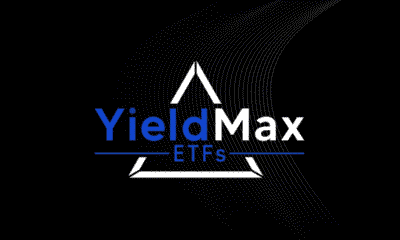
 Nyheter4 veckor sedan
Nyheter4 veckor sedanM5TYs senaste utdelningstakt (55 %) belyser covered call-strategins inkomstpotential
-

 Nyheter4 veckor sedan
Nyheter4 veckor sedanCould Bitcoin be the key to your dream house?
-

 Nyheter4 veckor sedan
Nyheter4 veckor sedanBörshandlade fonder för europeiska small caps
-

 Nyheter2 veckor sedan
Nyheter2 veckor sedanLevler noterar ytterligare fyra börshandlade fonder i Sverige
-

 Nyheter4 veckor sedan
Nyheter4 veckor sedanMiners Find Their Mojo as Gold Consolidates
-

 Nyheter4 veckor sedan
Nyheter4 veckor sedanTech multi-megatrend ETF utvecklar metodologi med tillägg av exponeringar mot kvantberäkning och försvarsteknik
-

 Nyheter4 veckor sedan
Nyheter4 veckor sedanState Street och Blackstone lanserar aktivt förvaltade CLO-ETFer i Europa


